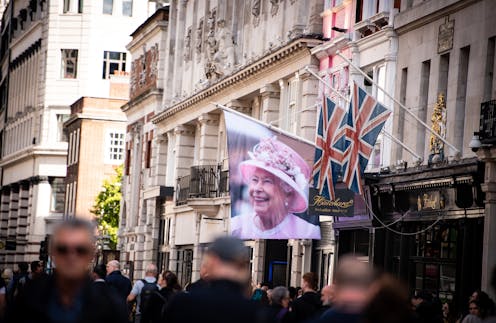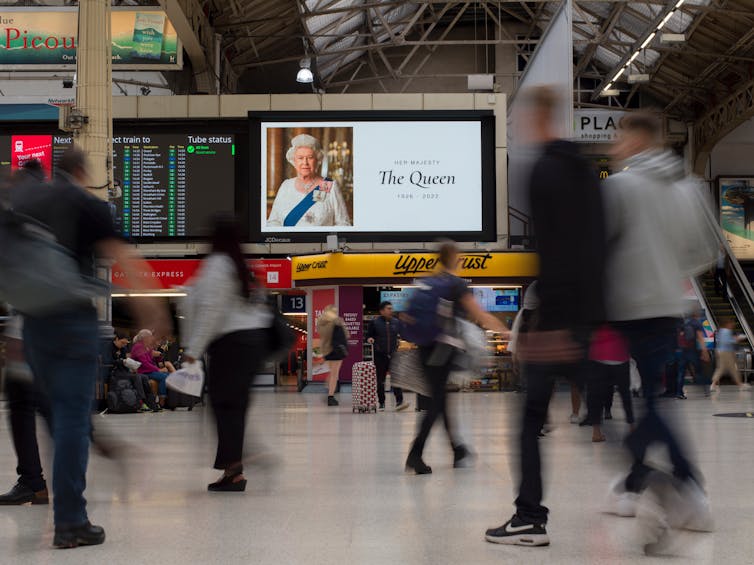
Loredana Sangiuliano / Shutterstock
A national mood, ambience, community spirit, a feeling in the air. There are many ways people might describe the collective sense of an intangible something that occurs around major events. My research explores what makes a national atmosphere. The events surrounding the death of the Queen have lent this work more significance than I had anticipated.
We feel part of a national atmosphere when public feelings are more intense than in everyday life. They comprise our own emotions, as well as the energies and feelings that travel between ourselves and other people.
We might feel pulled along by the atmosphere’s force and rhythms. Indeed, an atmosphere can sometimes have a life of its own. National atmospheres can be positive and jubilant or negative and frightening, and they have different resonances for different people.
The dominant national atmosphere around the Queen’s death was solemn and subdued. This mood was formed from thousands of tiny elements: flags at half mast, black-and-white images of the Queen in shop windows and on websites, military uniforms and announcements from businesses as to how they planned to mark the day of the funeral.
As it’s a national atmosphere, we don’t have to be in London or Windsor to experience it. Across the UK, condolence books appeared in supermarkets, estate agents replaced pictures of houses with images of the Queen, and school events were cancelled. Internationally, coverage of the funeral was broadcast on television and on public screens in city squares.

Electric Egg / Shutterstock
National atmospheres are formed through a combination of the rehearsed and the spontaneous. King Charles’s visits to all of the UK’s nations before the funeral was carefully choreographed, while mourners leaving marmalade sandwiches in tribute to the Queen were an unexpected touch.
A very different public mood took hold during the London 2012 Olympic Games, when people apparently bottled the joyful atmosphere and tried selling it for £50 on eBay. On the other hand, there was a sombre national mood during the COVID-19 pandemic. At least in the early days, it was socially unacceptable and not “in the spirit” of the national mood to break lockdown rules.
What a national atmosphere means
These moments of coming together are interesting politically. They tell us things about our society’s priorities, and can be turning points when new ideas about community and the future emerge.
The queue of people who waited in line for entire days to see the Queen lying in state has stood out as a memorable element of this national event. The queue was carefully planned and the public could watch it live on the BBC as well as track it online.
Looking at the footage, many of the visitors were women, and early analysis suggests most tended to be Conservative voters who had supported remaining in Europe. We might wonder what, of many different things, these people may be mourning.
People queueing had to walk past several significant national and urban sites, as well as those that remind us London once formed the “heart of empire”. For example, the Thames Embankment scheme was developed in the 19th century at the height of British imperial power.
The queue also passed the relatively new National COVID Memorial Wall for the hundreds of thousands people who have died in the UK from COVID-19. Perhaps some of the funeral crowds were mourning more than the death of a sovereign.

Photo by Angharad Closs Stephens, Author provided
National dissent
Although appearing to show people united in common feeling, a national atmosphere often also sparks pockets of resistance and dissent. But the problem with heightened proclamations of unity is that it becomes especially hard to challenge the national mood.
The American feminist philosopher Judith Butler remarked that it was difficult to critique the atmosphere of heightened nationalism that followed the September 11 2001 terrorist attacks and subsequent decisions to go to war against Afghanistan and Iraq. At such moments, dissent has to take creative and unexpected forms, somehow finding ways of interrupting, rather than spoiling the mood.
After multiple anti-monarchy protesters were arrested at events surrounding the change of sovereign, others demonstrated by holding up blank pieces of paper outside parliament. Such a protest avoided expressing an opinion that could get them arrested, but nevertheless made their sentiment known.
The mood of relative calm that followed the Queen’s death was, for many, a brief distraction from a summer of uncertainty. The UK experienced multiple heatwaves, fear over mounting energy bills and food costs, and political upheaval. There was a feeling of bubbling discontent that could spill over at any moment.
The UK government and the monarchy will hope the current mood of mourning stays in place. But public feelings rarely stay constant, and we all play a part in shaping them. While the government of the day can to some extent direct the national atmosphere, it can also find itself on the other side of the public mood, as other ideas about community and the future emerge.
![]()
Angharad Closs Stephens receives funding from SCoRE Cymru and AHRC Impact Acceleration Funds, and has been a recipient of a Leverhulme Research Fellowship.
Source: TheConversation


